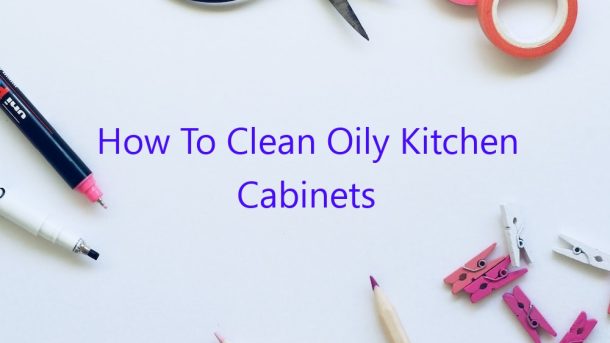Oily kitchen cabinets are a common problem in the kitchen, caused by cooking oils and fats. The oils can seep into the wood and cause the cabinets to become discolored and greasy. Over time, the oil can also cause the cabinets to become brittle and decay. In order to clean oily kitchen cabinets, you will need to use a combination of cleaning products and techniques.
The first step is to remove all of the contents from the cabinets. This will make it easier to clean the cabinets and to assess the damage. Once everything is removed, you can start by cleaning the surfaces of the cabinets with a degreaser. There are many commercial degreasers available, or you can make your own by mixing one part dish soap with one part white vinegar. Be sure to wipe the degreaser away with a clean rag, and allow the cabinets to dry completely.
If the cabinets are heavily greased, you may need to use a stronger cleaning product. Try using a paste made of baking soda and water. Apply the paste to a clean cloth and rub it into the greasy areas. Be sure to wipe away the paste and any residue with a clean rag.
If the cabinets are damaged or decayed, you may need to sand them down and re-stain or paint them. Be sure to follow the directions on the paint or stain product, and allow the cabinets to dry completely before putting anything back inside.
Cleaning oily kitchen cabinets can be a daunting task, but by using the right products and techniques, you can get the job done quickly and easily.
Contents [hide]
What is the best thing to use on greasy kitchen cabinets?
There are a few different things that you can use to clean greasy kitchen cabinets. The best option will depend on the severity of the grease, as well as the type of surface that the cabinets are made from.
If the grease is light, a mild detergent and water solution will usually be sufficient. However, if the grease is more severe, a commercial cleaner or degreaser may be necessary. Be sure to read the product label carefully to ensure that it is safe to use on the type of surface that your cabinets are made from.
If you are cleaning cabinets that are made from a non-porous surface such as laminate or vinyl, a non-abrasive cleaner such as Pledge or Murphy’s Oil Soap can be used. Be sure to avoid using products that contain ammonia or bleach, as these can damage the surface of the cabinets.
If the cabinets are made from a porous surface such as wood, a product that contains enzymes or oxygen-based bleach can be used. This will help to break down the grease and dirt that has built up on the surface of the cabinets. Be sure to follow the product instructions carefully, as over-application can damage the surface of the wood.
It is important to remember that the best way to prevent greasy cabinets is to clean them regularly. A damp cloth or a mild detergent solution can be used to clean light grease build-up, while a commercial cleaner or degreaser can be used for more severe build-up. Be sure to read the product label carefully to ensure that it is safe to use on the type of surface that your cabinets are made from.
What is good for cleaning grease off kitchen cabinets?
Grease is a common kitchen nuisance that can be difficult to remove. Fortunately, there are a variety of methods that can be used to clean grease off kitchen cabinets.
One popular method is to use a degreaser. Degreasers are specially formulated to dissolve grease and oil. There are a variety of degreasers available, both commercial and homemade. If you choose to use a commercial degreaser, be sure to read the label carefully to make sure it is safe to use on kitchen cabinets.
Another popular method is to use a vinegar and water solution. Vinegar is a natural degreaser and it also has antibacterial properties. To make a vinegar and water solution, mix one cup of vinegar with one gallon of water. soak a cloth in the solution and wipe down the cabinets. Be sure to rinse the cabinets with water afterwards to remove any vinegar residue.
A third popular method is to use a baking soda and water solution. Baking soda is a natural abrasive and it also has antibacterial properties. To make a baking soda and water solution, mix one cup of baking soda with one gallon of water. Soak a cloth in the solution and wipe down the cabinets. Be sure to rinse the cabinets with water afterwards to remove any baking soda residue.
The best way to remove grease from kitchen cabinets is to use a combination of methods. For example, you can start by using a degreaser to dissolve the grease. Then, you can use a vinegar and water solution to clean the cabinets. Finally, you can use a baking soda and water solution to polish the cabinets.
Why are my kitchen cabinets sticky after cleaning?
Cleaning your kitchen cabinets is a necessary task to keep them looking their best. However, sometimes you may notice that they are still sticky after cleaning. This can be frustrating, but there are a few possible reasons why this might happen.
One reason your cabinets might be sticky after cleaning is that you are not using the right cleaning products. Many cleaners contain chemicals that can leave a sticky residue behind. If your cabinets are still sticky after cleaning, try using a natural cleaner like vinegar or baking soda.
Another reason your cabinets might be sticky after cleaning is that they are not dry. If you do not allow the cabinets to dry completely before putting anything back in them, the moisture will cause the cabinets to become sticky. Make sure to allow the cabinets to dry completely before putting anything back in them.
Finally, it is possible that the adhesive on your cabinets is wearing off. Over time, the adhesive on cabinets can wear off, causing them to become sticky. If this is the case, you may need to re-apply the adhesive to your cabinets.
If your cabinets are still sticky after cleaning, try using a different cleaning product, allow the cabinets to dry completely, or re-apply the adhesive. By troubleshooting the issue, you should be able to get your cabinets looking their best once again.
How do you remove years of grime from kitchen cabinets?
If your kitchen cabinets are anything like mine, they’re covered in years of built-up grime. And while I’ve tried all sorts of methods to clean them, nothing has seemed to work. Until now.
The key to removing years of grime from kitchen cabinets is to use a degreaser. I tried a few different ones before finding the one that worked best for me. The one I use is called Krud Kutter, and it’s available at most hardware stores.
To use the degreaser, start by spraying it on a small area of the cabinet and let it sit for a few minutes. Then, use a scrub brush to scrub the area. Be sure to rinse it off with water when you’re done.
If there’s a lot of build-up on the cabinet, you may need to repeat this process a few times. But eventually, the grime will come off and your cabinets will be looking new again.
Can you use Dawn dish soap on wood cabinets?
Can you use Dawn dish soap on wood cabinets?
Yes, Dawn dish soap is safe to use on wood cabinets. It will help remove dirt and grease from the surface of the wood. Be sure to rinse the cabinets thoroughly after cleaning them with Dawn dish soap to remove all of the soap residue.
Why do top of cabinets get greasy?
If you’ve ever noticed a thick layer of grease on top of your kitchen cabinets, you’re not alone. This greasy film is caused by a combination of cooking oils and dust, and it can be difficult to remove. While you can’t stop the grease from building up over time, there are a few things you can do to make cleaning it up a little easier.
The first step is to identify the source of the grease. Oftentimes, it’s coming from cooking oils that have been spilled on the stovetop. If this is the case, you can prevent the grease from spreading by using a stovetop cover. You should also clean up any cooking oils as soon as they’re spilled, and be sure to use a damp cloth to wipe down the stovetop.
If the grease is coming from dust, there’s not much you can do to prevent it from building up. However, you can make cleaning it up a little easier by using a damp cloth to wipe down the cabinets on a regular basis. You may also want to consider using a cabinet liner to protect the wood from dust and grease.
Ultimately, the best way to keep your cabinets clean and grease-free is to be proactive. wipe them down on a regular basis, and clean up any cooking oils or spills as soon as they happen. With a little bit of effort, you can keep your kitchen looking its best.”
How do you make degreaser for kitchen cabinets?
Making your own degreaser for kitchen cabinets is easy and inexpensive. There are a few different recipes you can use, but all of them rely on simple ingredients that you may already have in your home.
One recipe for degreaser calls for 1 cup of ammonia, 1 cup of white vinegar, and 1 cup of water. Combine the ingredients in a spray bottle and shake well. Spray the degreaser on the cabinets and let it sit for a few minutes. Wipe the cabinets clean with a damp cloth.
Another recipe is made with baking soda and vinegar. Combine 1/2 cup of baking soda with 1/2 cup of vinegar in a spray bottle. Shake the bottle well and spray the degreaser on the cabinets. Let it sit for a few minutes, then wipe it clean with a damp cloth.
Both of these recipes are safe to use on wood cabinets. However, if you have plastic or laminate cabinets, be sure to test the degreaser in a small, inconspicuous area before using it on the entire cabinet.




